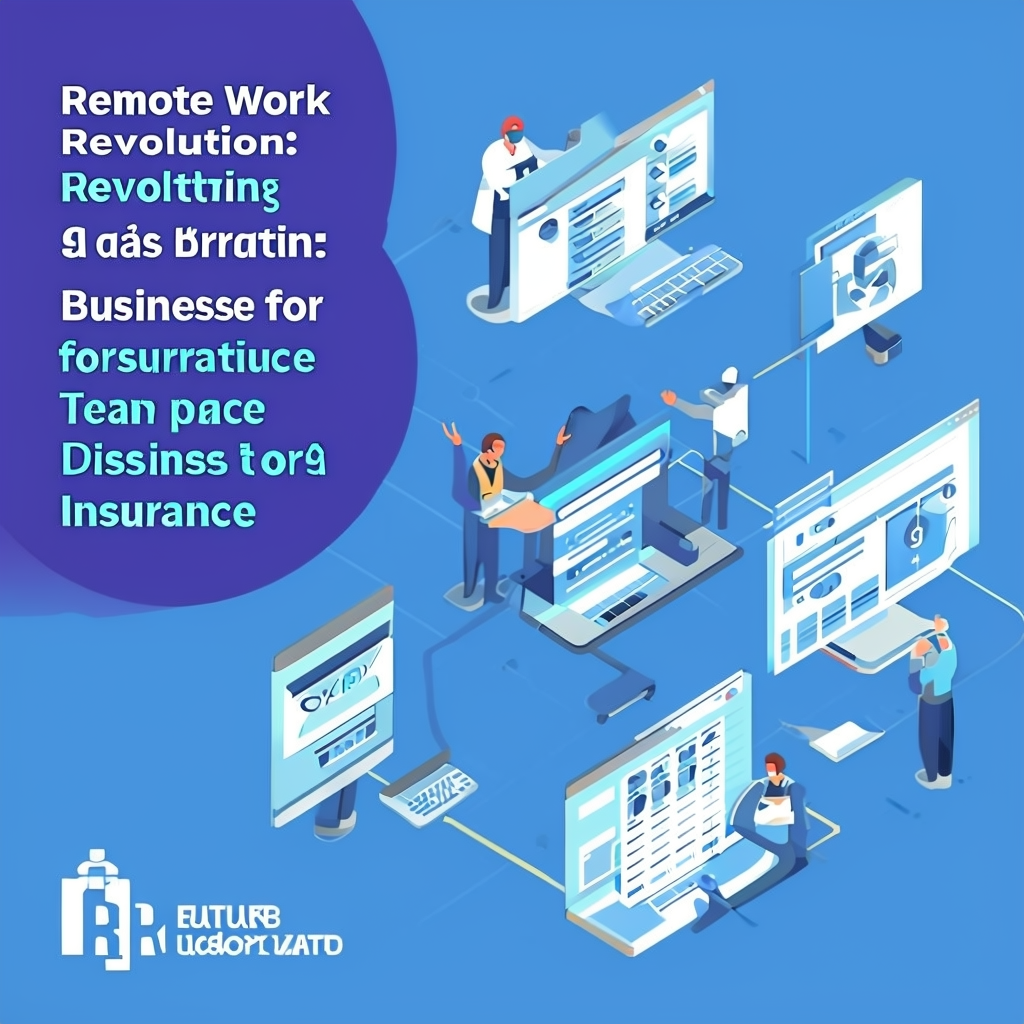Introduction
The remote work revolution has transformed the way businesses operate, offering flexibility and new opportunities for both employers and employees. As more companies embrace distributed teams, it becomes essential to reassess and adapt business insurance policies to address the unique risks associated with remote work. From workplace injuries to data security concerns, the shift to a remote workforce presents new challenges that require careful consideration. In this blog post, we will explore the implications of remote work on business insurance and provide guidance on how to ensure your coverage is adequate for a distributed team.
The Rise of Remote Work
Statistics on the Growth of Remote Work and Its Permanence in the Business Landscape
The rise of remote work has transformed the business landscape, particularly in the wake of the COVID-19 pandemic. According to a report from Stanford University, approximately 42% of the U.S. labor force was working remotely full-time as of mid-2020, a significant increase from just 24% in 2019. As businesses adapted to the challenges posed by the pandemic, many discovered the benefits of remote work, leading to a lasting shift in how organizations operate.
Recent surveys indicate that remote work is not just a temporary trend but a permanent fixture in the modern workplace. A Gallup poll found that 54% of employees would prefer to work remotely at least part of the time even after the pandemic subsides. Additionally, a report from McKinsey & Company revealed that 87% of employees want the flexibility to work remotely at least one day a week. This shift has prompted many companies to reevaluate their policies and embrace hybrid work models that combine in-office and remote work.
The permanence of remote work is further evidenced by the increasing number of companies that have adopted long-term remote work policies. Major organizations, including Twitter, Facebook, and Shopify, have announced plans to allow employees to work remotely indefinitely. This trend reflects a broader recognition that remote work can enhance productivity, employee satisfaction, and overall business performance.
Benefits of Remote Work for Businesses and Employees
The rise of remote work has brought numerous benefits for both businesses and employees. For organizations, remote work can lead to increased productivity and efficiency. Studies have shown that remote workers often experience fewer distractions and interruptions compared to their in-office counterparts, allowing them to focus more effectively on their tasks. Additionally, remote work can reduce overhead costs associated with maintaining physical office spaces, such as rent, utilities, and office supplies.
From an employee perspective, remote work offers greater flexibility and work-life balance. Employees can tailor their work environments to suit their preferences, leading to increased job satisfaction and morale. The ability to work from home or other locations can also eliminate commuting time, allowing employees to allocate more time to personal pursuits or family responsibilities. This flexibility can contribute to improved mental health and overall well-being, which, in turn, can enhance employee retention and reduce turnover rates.
Remote work opens up opportunities for businesses to tap into a broader talent pool. Companies are no longer limited to hiring talent within their geographic location, allowing them to attract skilled professionals from diverse backgrounds and regions. This diversity can foster innovation and creativity within teams, ultimately benefiting the organization as a whole.
Challenges That Come with Managing a Distributed Team
While remote work offers numerous advantages, it also presents unique challenges for managers and organizations. One of the primary challenges is maintaining effective communication and collaboration among team members. In a distributed work environment, employees may feel isolated or disconnected from their colleagues, leading to potential misunderstandings and decreased team cohesion. Managers must implement strategies to foster open communication, such as regular check-ins, virtual team meetings, and collaboration tools that facilitate real-time interaction.
Another challenge is ensuring accountability and productivity among remote workers. Without the traditional oversight of an office environment, managers may struggle to monitor employee performance and ensure that tasks are completed on time. Establishing clear expectations, setting measurable goals, and utilizing project management tools can help address this issue and promote accountability within the team.
Managing a distributed team requires a shift in leadership style. Managers must adapt to new ways of motivating and supporting their employees, focusing on results rather than micromanaging daily activities. This shift may involve providing additional resources for professional development, offering mental health support, and fostering a culture of trust and autonomy.
Finally, cybersecurity concerns are heightened in a remote work environment. With employees accessing company data from various locations and devices, organizations must implement robust security measures to protect sensitive information. This includes providing training on cybersecurity best practices, utilizing secure communication tools, and ensuring that employees have access to the necessary technology to work safely from home.
The rise of remote work has reshaped the business landscape, offering numerous benefits for both organizations and employees. However, it also presents challenges that require effective management strategies to ensure successful collaboration and productivity in a distributed work environment. As remote work continues to evolve, organizations must adapt to this new reality to thrive in the modern workplace.
Understanding the Insurance Implications of Remote Work
Overview of How Remote Work Changes the Risk Landscape for Businesses
The shift to remote work has significantly altered the risk landscape for businesses, introducing new challenges and considerations that organizations must address. Unlike traditional office environments, remote work settings can vary widely, with employees working from home, co-working spaces, or even while traveling. This diversity in work environments creates unique risks that businesses need to understand and manage effectively.
One of the primary changes in the risk landscape is the increased complexity of managing employee safety and well-being. In a remote work setting, employers may have limited visibility into the physical work environment of their employees. This can lead to challenges in ensuring that employees have safe and ergonomic workspaces, which can contribute to workplace injuries and health issues. For instance, employees may experience musculoskeletal disorders due to improper seating arrangements or inadequate equipment, leading to potential workers’ compensation claims.
The remote work model can complicate the management of cybersecurity risks. With employees accessing company data from various locations and devices, the potential for data breaches and cyberattacks increases. Organizations must implement robust cybersecurity measures to protect sensitive information and ensure compliance with data protection regulations. This includes providing employees with secure access to company networks, utilizing encryption, and offering training on best practices for data security.
The remote work environment can lead to challenges in maintaining company culture and employee engagement. A lack of in-person interaction may result in feelings of isolation among employees, which can impact morale and productivity. Businesses must find innovative ways to foster a sense of community and connection among remote teams, which can involve virtual team-building activities, regular check-ins, and open lines of communication.
As businesses navigate this new risk landscape, it is essential to reassess existing insurance policies and consider additional coverage options that address the unique challenges of remote work. This may include reviewing general liability insurance, workers’ compensation policies, and cybersecurity insurance to ensure that they adequately cover the risks associated with a distributed workforce.
Discussion of Potential Liabilities Associated with Remote Employees
The rise of remote work has introduced various potential liabilities that businesses must consider when managing a distributed workforce. One of the most significant concerns is the risk of workplace injuries occurring in remote settings. While employers are typically responsible for providing a safe work environment in traditional office spaces, the same level of oversight may not apply to employees working from home. This can lead to complications in workers’ compensation claims if an employee sustains an injury while performing work-related tasks in their home office.
For example, if an employee slips and falls while working from home, determining whether the injury is compensable can be challenging. Employers may need to establish clear policies regarding remote work safety and provide guidance on creating ergonomic workspaces to mitigate these risks. Additionally, businesses should consider offering resources or stipends for employees to invest in proper office equipment, such as chairs and desks, to promote a safe working environment.
Another critical liability associated with remote employees is data security. As employees access sensitive company information from various locations, the risk of data breaches and cyberattacks increases. Organizations must ensure that they have robust cybersecurity measures in place to protect against unauthorized access and data loss. This includes implementing secure virtual private networks (VPNs), multi-factor authentication, and regular security training for employees.
Businesses must be aware of the legal implications of remote work, particularly regarding data protection regulations. Depending on the jurisdiction, organizations may be subject to specific laws governing the handling of personal data, such as the General Data Protection Regulation (GDPR) in the European Union. Non-compliance with these regulations can result in significant fines and legal repercussions, making it essential for businesses to understand their obligations and implement appropriate data protection measures.
Remote work can lead to potential liabilities related to employee productivity and performance. Employers may face challenges in monitoring employee performance and ensuring that remote workers remain engaged and accountable. This can result in disputes over performance evaluations, leading to potential legal claims if employees feel they have been treated unfairly.

Importance of Understanding the Legal and Regulatory Implications of Remote Work
As remote work becomes a permanent fixture in the business landscape, understanding the legal and regulatory implications is crucial for organizations. The shift to a distributed workforce introduces various legal considerations that businesses must navigate to ensure compliance and mitigate potential risks.
One of the primary legal implications of remote work is the need to comply with labor laws and regulations that may vary by jurisdiction. For instance, employers must be aware of wage and hour laws, including regulations regarding overtime pay and meal breaks, which can differ based on where employees are located. This is particularly important for businesses with employees working in multiple states or countries, as they may be subject to different labor laws that impact payroll and employee rights.
Businesses must consider the implications of remote work on employee classification. Misclassifying employees as independent contractors or failing to comply with employment laws can lead to significant legal liabilities. Organizations should ensure that they have clear policies in place regarding employee classification and that they are compliant with relevant labor regulations.
Additional Coverage Considerations
Equipment Insurance
Coverage for Company-Owned Equipment Used by Remote Employees
As remote work becomes increasingly common, businesses must consider the implications of equipment insurance for company-owned devices used by remote employees. Equipment insurance provides coverage for physical assets, such as computers, laptops, and other technology that employees use to perform their job duties from home or other remote locations. This coverage is essential for protecting the organization’s investment in technology and ensuring that employees have the necessary tools to work effectively.
When employees work remotely, they may use company-owned equipment in various environments, which can increase the risk of damage or loss. For instance, a laptop may be accidentally damaged during travel, or a desktop computer may be stolen from an employee’s home. Equipment insurance can help cover the costs of repairing or replacing damaged or lost devices, minimizing the financial impact on the business.
Businesses should consider the importance of having clear policies regarding the use and care of company-owned equipment. This may include guidelines on how employees should handle devices, security measures to protect against theft, and procedures for reporting damage or loss. By establishing these policies, organizations can help mitigate risks and ensure that employees are aware of their responsibilities regarding company equipment.
Businesses may also want to explore options for insuring equipment that employees purchase for remote work. Some companies offer stipends or reimbursements for home office setups, and having insurance coverage for these assets can provide additional peace of mind. By investing in equipment insurance, businesses can protect their assets and ensure that remote employees have the tools they need to succeed.
Business Interruption Insurance
How to Adapt Coverage to Account for Remote Work Disruptions
Business interruption insurance is designed to provide financial protection against income loss due to unforeseen events that disrupt normal operations. As remote work becomes more prevalent, businesses must adapt their business interruption coverage to account for the unique challenges associated with a distributed workforce.
In a traditional office setting, business interruption insurance typically covers losses resulting from physical damage to the premises, such as fire or natural disasters. However, with remote work, disruptions may arise from different sources, such as cybersecurity incidents, supply chain disruptions, or even changes in employee availability due to personal circumstances. Organizations should assess their specific risks and consider how these factors may impact their operations.
To adapt business interruption insurance for remote work, businesses should evaluate their coverage limits and ensure they adequately reflect potential income losses associated with remote work disruptions. This may involve analyzing historical data on revenue fluctuations during previous disruptions and considering the potential impact of remote work on overall productivity.
Businesses should communicate with their insurance providers to understand how their policies can be tailored to address the unique risks of remote work. Insurers may offer specialized coverage options or endorsements that can enhance protection against income loss due to remote work-related disruptions.
Organizations should develop contingency plans to address potential disruptions in remote work. This may include strategies for maintaining communication and collaboration among remote teams, ensuring access to critical resources, and implementing backup plans for technology failures. By proactively addressing these challenges, businesses can minimize the impact of disruptions and ensure continuity of operations.
Health and Safety Insurance
Importance of Ensuring Employee Safety in a Remote Work Environment
In a remote work environment, ensuring employee safety is paramount, and health and safety insurance plays a crucial role in protecting both employees and employers. While traditional workplace safety measures may not apply in a home office setting, businesses still have a responsibility to promote a safe and healthy work environment for their remote employees.
Health and safety insurance can cover various aspects of employee well-being, including mental health support, ergonomic assessments, and resources for creating safe home office setups. As remote work can lead to feelings of isolation and stress, providing access to mental health resources is essential for supporting employee well-being. This may include offering employee assistance programs (EAPs) that provide counseling services and mental health support.
Businesses should consider implementing ergonomic assessments to ensure that employees have safe and comfortable workspaces. This may involve providing guidelines on proper workstation setup, offering stipends for ergonomic furniture, or conducting virtual assessments to identify potential hazards in home office environments. By prioritizing employee safety, organizations can reduce the risk of work-related injuries and promote overall well-being.
Businesses should establish clear health and safety policies that outline expectations for remote work environments. This may include guidelines on reporting workplace injuries, maintaining a safe workspace, and accessing health resources. By fostering a culture of safety and well-being, organizations can enhance employee satisfaction and productivity while minimizing potential liabilities.
As remote work continues to shape the business landscape, organizations must consider additional coverage options to address the unique challenges associated with a distributed workforce. Equipment insurance, adapted business interruption insurance, and health and safety insurance are essential components of a comprehensive risk management strategy that protects both employees and the organization as a whole. By investing in these coverage options, businesses can navigate the complexities of remote work while ensuring the safety and well-being of their employees.
FAQs
Q: What is the remote work revolution?
A: The remote work revolution refers to the significant shift towards remote and flexible work arrangements, where employees work from various locations instead of a traditional office setting.
Q: How does remote work affect business insurance needs?
A: Remote work can change your business insurance needs by increasing the importance of cyber liability insurance, adjusting workers’ compensation coverage, and considering general liability for remote employees.
Q: Do I need different insurance for remote employees?
A: Yes, you may need to adjust your insurance policies to cover remote employees, including ensuring that your workers’ compensation and liability insurance extend to off-site work environments.
Q: What type of insurance is essential for a remote team?
A: Essential insurance for a remote team includes cyber liability insurance to protect against data breaches, general liability insurance, and possibly professional liability insurance, depending on your industry.
Q: How can I ensure my remote team is covered under my insurance policy?
A: To ensure coverage, review your current policies with your insurance provider, update them to include remote work scenarios, and communicate any changes in employee locations or work practices.
Q: Should I consider additional coverage for remote work tools and technology?
A: Yes, consider additional coverage for tools and technology used by remote employees, such as equipment insurance or cyber insurance, to protect against potential risks associated with remote work setups.
Conclusion
In conclusion, adapting your business insurance for a distributed team is not just a matter of compliance; it’s a strategic necessity in today’s evolving work environment. As remote work continues to shape the future of business, understanding the unique risks and adjusting your insurance coverage accordingly will help protect your organization from unforeseen challenges. By conducting thorough risk assessments, communicating with your insurance provider, and implementing strong cybersecurity measures, you can ensure that your business is well-prepared for the demands of a remote workforce. Embrace the future of work with confidence, knowing that your insurance is tailored to meet the needs of your distributed team.




